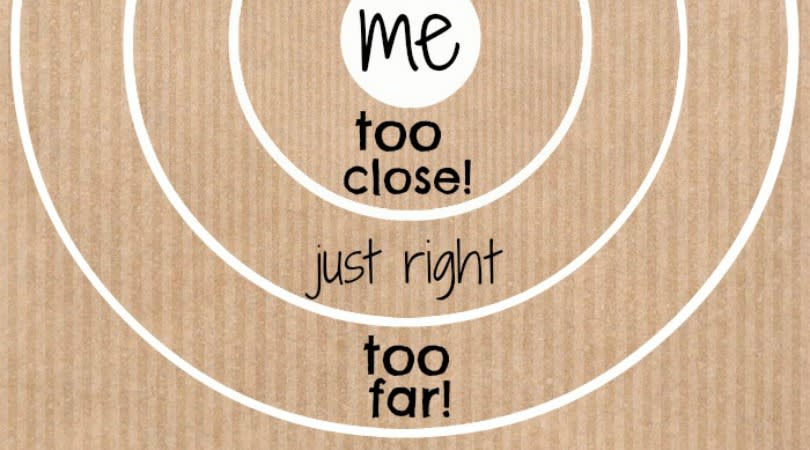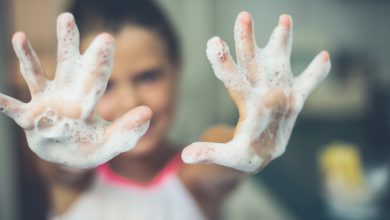30 Fun Personal Space Activities + Teaching Boundaries Games

Personal Space Activities & Personal Space Games
While talking about personal space with kids is great, it’s a real-world application that will help teach them about boundaries. By identifying what personal space is and where the boundaries actually stand, kids will understand how to protect their own space and know how to make space for others.
What better way to learn about personal space than with some games and activities?
These personal space activities for kids are a great way for kids to learn how to respect the personal space of others and work on protecting their own personal space.
A little low-pressure, intentional, playful learning will always help drive home an important topic. (These personal space activities and games would also work well as a way to get the conversation started.)


Finding activities and games that were designed for teaching personal space was tricky. I’ve searched out a list of kid activities that can be modified and used as personal space activities to help teach the concept of personal space.
If you have some others in mind please add them in the comments.
Personal Space Activities and Games for Kids to Learn About Their Body
When kids feel comfortable with their bodies, understand their bodies, and can identify parts of their bodies they can defend their personal space easier.
Saying, “Your hand is really close to my face, will you back up a bit.” will be much easier if they know what a hand and face are. Look through all of the following body awareness activities and see which one will work best for your family. (Or mix and match ideas!)
- Hokey Pokey Roll & Sing – I Can Teach My Child is especially great for very young kids who are just starting to learn about their bodies.
- All About Me Bones – Confidence Meets Parenting
- Move Them Bones Skeleton Yoga – Yo Re Mi has a great video for moving body parts as they get to understand what they are.
- Life Size Body Art – Candice Ashment Art
- Simon Says – Have one person call out and action using different body parts. Everyone else follows that action ONLY if the leader started with Simon Says. An example would be Simon Says put your hands above your head. If someone does an action when Simon Says was not used, they become Simon.
Personal Space Activities and Games for Kids to Study Body Language
Reading body language plays a HUGE part in personal space, and it can be a pretty difficult subject to teach.
I’ve compiled a few ideas and added tips on how to use them to start practicing the art of understanding body language.
- Emotional Animals Game – How Sweeter It Is. This game is fantastic! And simple (we love simple, right?) If you don’t want to make blocks, just tape the words onto dice. Each time your little one works to figure out how to show emotion, they are putting conscious effort into learning about body language (and having fun at the same time).
- Funny Body Parts – Playing and Learning Begins at Home. This silly game would be a great way to start looking at body language in pictures. Try to provide pictures that show real emotion. Ask your kids to design an angry person, an excited person, and a sad person. Talk about how they can tell the person is feeling that way. Is it their eyes? Or maybe the position of their hands?
- Pipe Cleaner People – Use Your Coloured Pencils. I found a few different versions of pipe cleaner people, this one really spoke to me as a way to show body language. It would make a really fun personal space activity. Start by forming 3 or 4 people. Give their bodies dramatic language. Ask your kids to find the person who is excited, sad, or uncomfortable. Have them position the people as though in a story. This guy is too close, so she looks uncomfortable.
- Simple Stop Action – Inner Child Fun. Once you have the pipe cleaner people made, you can add even more personal space practice by creating a simple stop-action movie that they can watch again and again!
- Feeling Faces Cards – NCPMI has a great printable with a wide range of emotions and real children displaying their feelings.
Personal Space Activities for Kids to Practice Communication and Consent
When kids are learning about personal space, they need to be able to communicate what they want and need. They must also be able to hear the needs and wants of others.
These activities are great ways to practice communication. You can take them a step further and discuss consent and talking to someone they trust about their boundary needs.
Personal Space Games and Activities for Kids to Play with Space
This list of games and activities allows you to experiment with personal space in a fun way. Make sure that while you are playing you pay attention to body language and practice communicating how it feels to have someone in that space.
- Rabbit Hole – The Inspired Tree House
- Teamwork activities – Confidence Meets Parenting
- Control – O – Meter – Autism Teaching Strategies
- Hip Waddle – Have two kids stand side by side. Arrange a ball or balloon between them. They will have to adjust their distance to keep the ball in place. If they get too far, it will drop. Make it even more challenging by having them move through the room while keeping the ball between them.
- Newspaper Dancing – Mrs. King Rocks
- Personal Space Bubble – Each kid gets a hula hoop. Have them stand in the center of their hoop, holding it around their waste. Walk around the room using the hula hoop as a guide for how much space they have between things and people. Talk about whether this is too much space, just the right amount of space, or not enough space for them to be comfortable.
Personal Space Books for Kids
Books are a great way to approach uncomfortable topics. I found two books that come at personal space from different angles. These are affiliate links.
- Personal Space Camp
by Julia Cook shares a journey of a boy who learns strategies for respecting other people’s personal space. There is even a light bulb moment where he realizes how others might feel about him being in their space.
- Miles is the Boss of His Body by Samantha Kurtzman-Counter and Abbie Shiller follows a boy on his birthday. Out of love, his family touches him all day. Tossing his hair, big birthday hugs, cheek pinches, and innocent tickles come from all over. In the end, he tells them to stop and asks not to be touched. His family is proud of him for protecting his body. I love this message!
- My Body Bubble: A Children’s Book About Personal Boundaries, Consent and Respect, Kids Safety, Emotions & Feelings by Michael Gordon.
- Harrison P. Spader, Personal Space Invader by Christianne Jones is both funny and easy to understand. Harrison learns about his own personal space with a rhyme that the reader can use as they navigate the world of boundaries.
- Let’s Talk About Body Boundaries, Consent and Respect: Teach children about body ownership, respect, feelings, choices, and recognizing bullying behaviors by Jayneen Sanders.
- Teach Your Dragon Body Safety: A Story About Personal Boundaries, Appropriate and Inappropriate Touching by Steve Herman.
Personal Space Synonym
We’ve used the terms personal space and boundaries. These words might be great for some kids and not resonate with other kids. Here’s a list of words that can be sued in place of personal space.
- personal distance
- proximity
- private space
- private time
- alone time
- separation
- solitude
- retreat
- room to move
- breathing space
- comfortable distance
These personal space activities for kids should get you started! Add more to the comments or just let us know which ones are working for your family.





